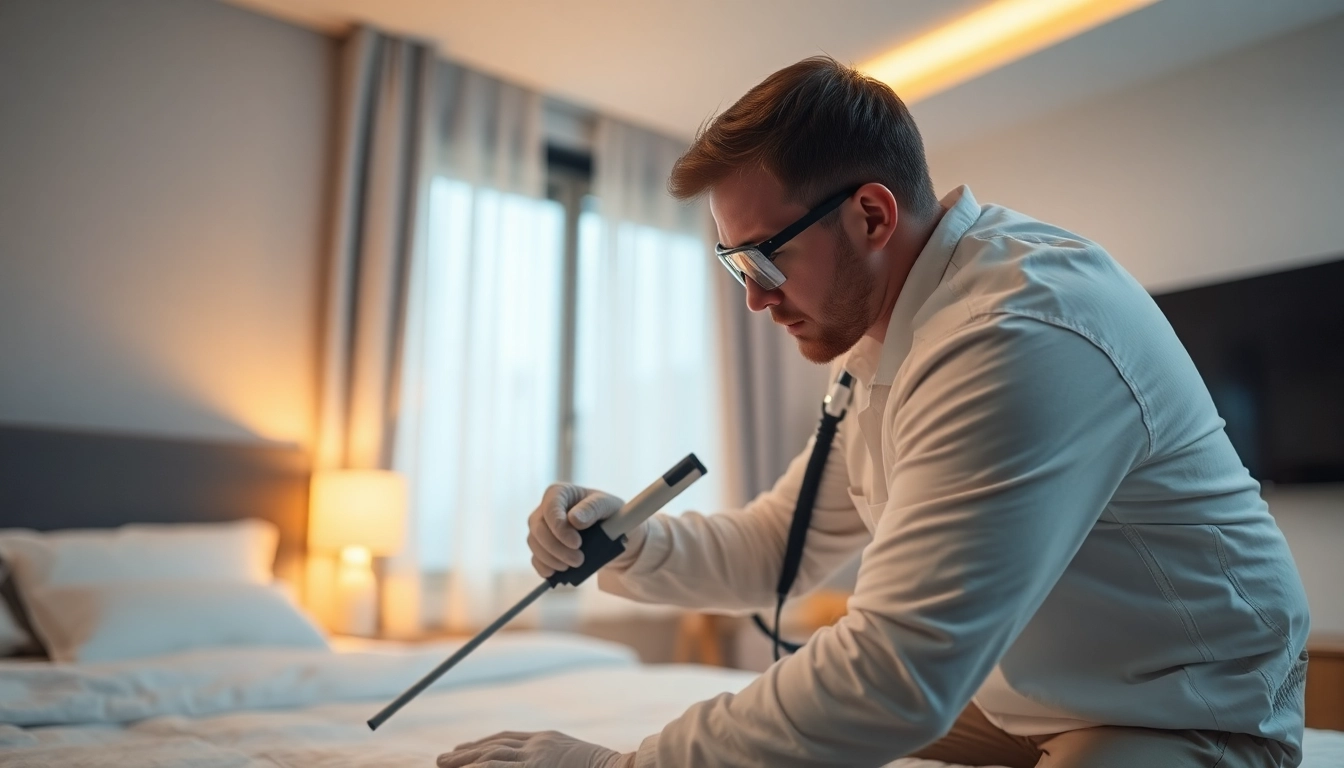Understanding Bed Bugs
What Are Bed Bugs?
Bed bugs are small, reddish-brown insects that belong to the family Cimicidae and typically feed on the blood of humans and other warm-blooded animals. They are oval-shaped, approximately 4-5 mm in length, and can be challenging to detect due to their nocturnal habits and impressive ability to hide in small cracks and crevices. This prowess enables them to thrive in various environments, including residential homes, hotels, and public transportation systems.
Signs of Infestation
Recognizing a bed bug infestation early is crucial for effective bed bug pest control. Common signs include:
- Visible Bed Bugs: Spotting live bed bugs during the day, particularly in bedding or mattresses.
- Bug Bites: Multiple bite marks on the skin, often arranged in a line or cluster.
- Blood Stains: Small red or brown stains on sheets or bedding, indicating crushed bugs.
- Fecal Spots: Tiny, dark spots indicating bed bug droppings, often found near their hiding spots.
- Shed Skins: The presence of exoskeletons as bed bugs molt during their life cycle.
Health Risks Associated with Bed Bugs
While bed bugs are not known to transmit diseases, their presence can lead to several health issues, including:
- Allergic Reactions: Some individuals may experience allergic reactions to bed bug bites, leading to intense itching and swelling.
- Secondary Infections: Scratching the bites can cause skin infections.
- Insomnia and Anxiety: Worrying about bed bugs can disrupt sleep and lead to anxiety and distress.
Effective Bed Bug Control Methods
Professional Pest Control Services
For extensive infestations, enlisting the help of professional pest control services focused on bed bug pest control is often the most effective approach. These experts employ a variety of methods, including chemical treatments, heat treatments, and steam cleaning, to eliminate bed bugs effectively. Professional services typically follow these steps:
- Inspection: A thorough inspection is performed to identify the extent of the infestation.
- Preparation: Homeowners are guided on how to prepare their space for treatment.
- Treatment: Pest control professionals implement their chosen methods of extermination.
- Follow-up: Many services include follow-up inspections to ensure all bed bugs have been eliminated.
DIY Bed Bug Removal Techniques
For those looking to tackle bed bugs independently, several DIY methods can help control smaller infestations, though they often require persistence and thoroughness. Techniques include:
- Vacuuming: Regularly vacuuming carpets, furniture, and bedding can significantly reduce the number of visible bed bugs.
- Heat Treatment: Washing infested bedding and clothing in hot water or placing items in a hot dryer can kill bed bugs at all life stages.
- Diatomaceous Earth: This natural powder can be sprinkled in areas where bed bugs are suspected, as it can damage their exoskeleton and lead to dehydration.
- Steam Cleaning: High-temperature steam can effectively kill bed bugs and their eggs on contact.
Using Integrated Pest Management (IPM)
Implementing an Integrated Pest Management (IPM) approach combines multiple strategies for efficient control of bed bugs:
- Monitoring: Regularly check for signs of bed bugs using traps and visual inspections.
- Table of Treatments: Utilize both chemical and non-chemical methods in harmony for a comprehensive strategy.
- Education: Stay informed on bed bug behavior and prevention measures to reduce the risk of re-infestation.
Preparing for Bed Bug Treatment
Pre-Treatment Checklist
Before treatment, homeowners should follow a checklist to enhance the treatment’s effectiveness:
- Clean Bedding and Clothing: Strip beds, wash all linens, and store in sealed plastic bags.
- Declutter: Remove unnecessary items from floors and surfaces, making treatment areas accessible.
- Notify Neighbors: Inform neighbors if you live in an apartment or shared building, as bed bugs can easily spread.
Setting up a Treatment Area
During treatment, ensure the area is prepared appropriately:
- Remove Pets: Keep pets away from treated areas during and after treatment.
- Seal Cracks: Seal non-affected areas before treatment to prevent bed bugs from fleeing and spreading.
- Remove Furniture: If possible, move affected furniture away from walls to allow for comprehensive treatment.
Post-Treatment Care
After treatment, follow these steps to ensure effective results:
- Re-checking: Conduct follow-up inspections and monitor for new signs of bed bugs.
- Maintain Cleanliness: Regularly vacuum and clean bedding and carpets.
- Education: Learn about bed bug behavior to prevent future infestations.
Costs of Bed Bug Pest Control
Understanding Treatment Costs
The cost of bed bug pest control can vary widely depending on the severity of the infestation, the type of treatment used, and the size of the home. Typically, treatments can range from a few hundred to several thousand dollars. Understanding these costs involves considering:
- Initial Inspection Fees: Many companies charge for the initial inspection, which is often credited towards treatment.
- Type of Treatment: Heat treatments tend to be more expensive than chemical treatments but can be more effective in severe cases.
Insurance and Coverage Options
It’s essential to check if your homeowner’s insurance policy covers bed bug treatments, as many policies do not. If seeking assistance, ask for clarification regarding coverage and potential reimbursement options. Pest control companies may also offer payment plans or financing for expensive treatments.
Cost-Effective DIY Solutions
While professional treatments can be effective, several DIY solutions can also be cost-effective:
- Natural Remedies: Such as essential oils—including tea tree oil—which have been found to repel and kill bed bugs.
- Heat Exposure: Utilizing high heat can effectively kill bed bugs at all life stages, making this one of the most accessible DIY methods.
Preventing Future Infestations
Best Practices to Keep Your Home Bed Bug-Free
Once you have dealt with a bed bug infestation, implementing best practices can help keep your home bed bug-free:
- Regular Inspections: Regularly check sleeping areas, luggage, and electronics for signs of bed bugs, especially after traveling.
- Use Protective Covers: Invest in encasements for mattresses and box springs to prevent bed bug entry.
- Maintain Cleanliness: Regular vacuuming and dusting can significantly reduce hiding places for bed bugs.
Identifying Vulnerable Areas
Understanding where bed bugs are likely to hide can aid in effective prevention:
- Bedding and Furniture: Regularly inspect areas where people sleep or lounge.
- Traveling: Check hotel beds, luggage, and other travel gear upon return home.
Ongoing Maintenance and Monitoring
Preventing future infestations requires ongoing vigilance:
- Monitoring Traps: Consider setting up monitoring traps to catch any potential bed bugs.
- Regular Cleaning: Persistence in maintaining cleanliness will help to keep a safe environment.



